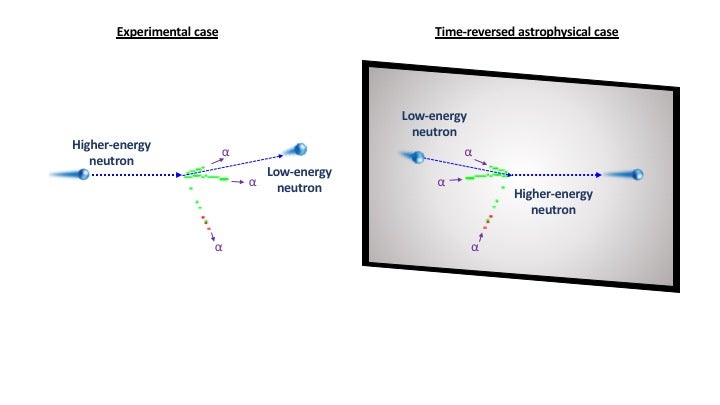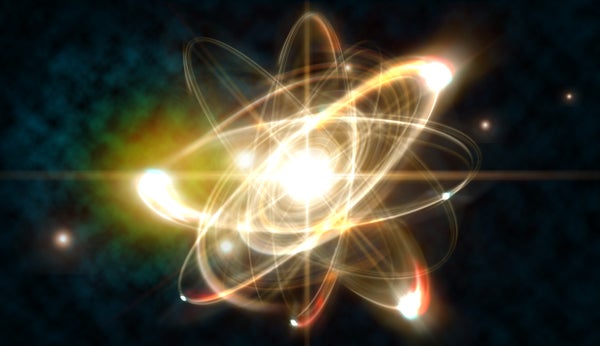Carbon, the building block of life, is thought to have formed mainly inside the cores of stars. But a new experiment is testing another idea: some of it may have been forged during supernova blasts or the collisions of neutron stars. To make a nucleus of carbon-12—the most common form of the element, with six protons and six neutrons—a rare process must occur: three helium-4 nuclei (also called alpha particles and containing two protons and two neutrons each) needto come together, reach a unique excited state and combine to form carbon. Scientists estimate that stable carbon atoms result only about four out of every 10,000 times three helium-4 isotopes unite. Traditionally, this “triple-alpha” process of carbon formation is thought to play out inside stellar cores, but a new particle accelerator experiment at Ohio University aims to test a different scenario where the element can be produced more efficiently with the help of neutrons, which are present when stars explode and collide.
Our current understanding of the triple-alpha process largely came from astronomer Fred Hoyle, who famously predicted, in 1954, that a special excited state of carbon-12 must arise during synthesis. Later scientists observed this so-called Hoyle state and confirmed that the carbon then emitted gamma rays to de-excite down to its ground, or stable, state.
Scientists have long suspected that other particles might play a role in that de-excitation, especially neutrons, which carry no electrical charge and can penetrate nuclei and take away extra energy. Measuring neutron energies has been difficult, however. A few years ago, physicist Lee Sobotka of Washington University in St. Louis decided the time was right to develop an experiment to test this idea. He read a paper in Physics Review Letters that predicted neutrons could enhance the triple-alpha process by a factor of more than 100. And he thought a technology called a time projection chamber (TPC), which was relatively new to nuclear physics, could be the right tool for the job.
On supporting science journalism
If you're enjoying this article, consider supporting our award-winning journalism by subscribing. By purchasing a subscription you are helping to ensure the future of impactful stories about the discoveries and ideas shaping our world today.
The fully realized experiment began at the Edwards Accelerator Laboratory at Ohio University on March 10. It features a TPC-type detector called the Texas Active Target, or TexAT, which was developed by Sobotka’s collaborators at Texas A&M University. The detector looks like a microwave oven with a front window, and it is installed at the near end of a 30-meter-long, two-meter-wide underground tunnel that was originally designed for neutron measurements. A 50-year-old, school-bus-sized on-site particle accelerator creates a beam of neutrons, then shoots them into the detector, where they bombard a sample of carbon dioxide gas. “What we are doing here is to measure the cross section, or probability, of an inverse reaction of the original triple-alpha process,” Sobotka says. Because the Hoyle state can exist for only a blink of an eye, it is almost impossible to directly measure it. In the reverse reaction, neutrons will hit carbon nuclei, excite them to the Hoyle state, produce alpha particles and then leave the scene with a lower energy. “It’s a clever approach to measuring the probability that the Hoyle state is de-excited in a collision with the neutron by performing the inverse measurement,” says Martin Freer of the University of Birmingham in England, who is not involved in the experiment.

Illustration of a triple-alpha event observed at the ongoing Texas Active Target (TexAT) experiment. The left-hand side shows the experimental case, with a fast neutron and a carbon-12 atom combining to create three alpha particles and a slow neutron. On the right is a time-reversal mirror showing what would actually happen in space: three alphas and a slow neutron merge to make carbon-12 and a fast neutron. Credit: Jack Bishop Texas A&M University
Measuring the reverse reaction is reasonable because there is a statistical relationship between the probabilities of that reaction and the original, says Grigory Rogachev of Texas A&M University, who is head of the TexAT team. TexAT, which took scientists six years to develop, can take photographs of charged particles inside the detector, he says. In this experiment, when alpha particles are knocked out and scatter off in different directions, they ionize the gas and set electrons free along the way. These electrons, in turn, yield to an electrical field in the detector and drift upward to the top detection panel, where their spatial positions are immediately marked down. Combining this information with their time of arrival, scientists can easily reconstruct the 3-D tracks of alpha-particles in a visual way.
Identifying the so-called alpha decay of the Hoyle state is a hard thing to do at the low energy relevant to this measurement, says Hans Fynbo of Aarhus University in Denmark, who is not involved in the study. The novelty of TexAT, he says, is that it’s “both the detector and the target,” which is a relatively new concept in experimental nuclear physics.
On the first day of the experiment, about 5,000 neutrons were fed into the detector each second. Only about one out of a million of them triggered the reverse triple-alpha process. Most of them just passed through the detector to the depth of the tunnel and into the hillside housing the accelerator lab.
The researchers were collecting about one event every five minutes, which was quite successful, according to Freer and Fynbo. The experiment was planned to run for two weeks, but the team had to abandon the detector in the tunnel after the first week when the campus was evacuated for the coronavirus. The researchers plan to return as soon as they can to collect their data and analyze the findings. If the results prove the predicted enhancement factor of 100, “it will be something quite significant,” Fynbo says.
Once the data are available, the next step will be to invite astrophysicists to join the conversation and interpret the cosmic environment needed for such neutron-induced carbon formation, Sobokta says. The scenario could be quite different from the quiet burning processes in a star. It may be “a supernova or a neutron-star merger,” in which not only the density of particles is higher but more neutrons can be present, Freer says. Yet carbon created in such cataclysmic processes may not necessarily increase the total amount of carbon in the universe significantly because they act “as seeds for the synthesis of heavier elements produced in these explosions,” he notes. In other words, these carbon atoms may get absorbed in creating other members of the periodic table.
